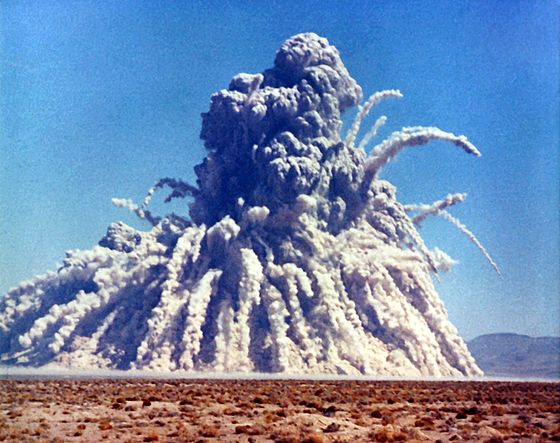Video: https://youtu.be/ZrI-VFYebnA
The Plowshare project developed the Sedan test in order to determine the feasibility of using nuclear detonations to quickly and economically excavate large amounts of earth and rock. Proposed applications included the creation of harbors, canals, open pit mines, railroad and highway cuts through mountainous terrain and the construction of dams. This is a little piece about the Sedan test. Sedan was a 104 Kt nuclear explosion detonated on July 6, 1962 at the Nevada Test Site, creating a crater 1280 ft wide by 320 ft deep. The Sedan device was buried at a depth of 635 ft below the Nevada desert surface. Jump to search
| Storax Sedan | |
|---|---|

Storax Sedan explosion.
| |
| Information | |
| Country | United States |
| Test series | Operation Storax Operation Plowshare |
| Test site | Nevada Test Site |
| Date | July 6, 1962 |
| Test type | Underground |
| Yield | 104 kt |
Storax Sedan was a shallow underground nuclear test conducted in Area 10 of Yucca Flat at the Nevada National Security Site on July 6, 1962 as part of Operation Plowshare, a program to investigate the use of nuclear weapons for mining, cratering, and other civilian purposes.
The radioactive fallout from the test contaminated more US residents than any other nuclear test. The Sedan Crater is the largest human-made crater in the United States, and is listed on the National Register of Historic Places.
Sedan was a thermonuclear device with a fission yield less than 30% and a fusion yield about 70%.
According to Carey Sublette, the design of the Sedan device was similar to that used in Shot Bluestone and Swanee of operation Dominic conducted days and months prior to Sedan respectively, and was therefore not unlike the W56 high yield Minuteman I missile warhead.
The device had a diameter of 43 cm (17 in), length of 96.5 cm (38.0 in), and a weight of 212.2 kg (468 lb).
The timing of the test put it within the Operation Storax fiscal year, but Sedan was functionally part of Operation Plowshare, and the test protocol was sponsored and conducted by Lawrence Livermore National Laboratory with minimal involvement by the United States Department of Defense.
The explosive device was lowered into a shaft drilled into the desert alluvium 194 m (636 ft) deep. The fusion-fission blast had a yield equivalent to 104 kilotons of TNT (435 terajoules) and lifted a dome of earth 90 m (300 ft) above the desert floor before it vented at three seconds after detonation, exploding upward and outward displacing more than 11,000,000 t (11,000,000 long tons; 12,000,000 short tons) of soil.
The resulting crater is 100 m (330 ft) deep with a diameter of about 390 m (1,280 ft). A circular area of the desert floor five miles across was obscured by fast-expanding dust clouds moving out horizontally from the base surge, akin to pyroclastic surge.
The blast caused seismic waves equivalent to an earthquake of 4.75 on the Richter scale.
The radiation level on the crater lip at 1 hour after burst was 500 R per hour (130 mC/(kg·h)), but it dropped to 500 mR per hour after 27 days.
Within 7 months (~210 days) of the excavation, the bottom of the crater could be safely walked upon with no protective clothing, with radiation levels at 35 mR per hour after 167 days.
Conclusions
The Plowshare project developed the Sedan test in order to determine the feasibility of using nuclear detonations to quickly and economically excavate large amounts of earth and rock. Proposed applications included the creation of harbors, canals, open pit mines, railroad and highway cuts through mountainous terrain and the construction of dams. Assessment of the full effects of the Sedan shot showed that the radioactive fallout from such uses would be extensive. Public concerns about the health effects and a lack of political support eventually led to abandonment of the concept. No such nuclear excavation has since been undertaken by the United States, though the Soviet Union continued to pursue the concept through their program Nuclear Explosions for the National Economy, particularly with their 140 kiloton Chagan (nuclear test), which created an artificial lake reservoir (see Lake Chagan).

No comments:
Post a Comment